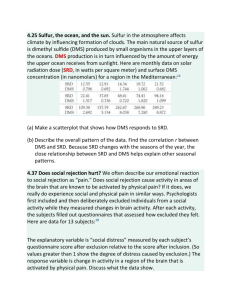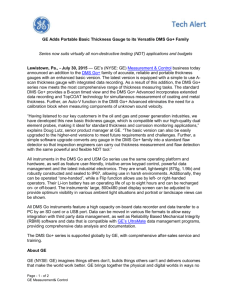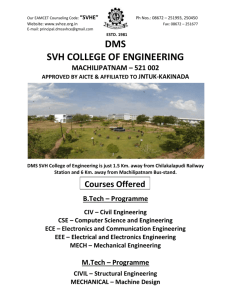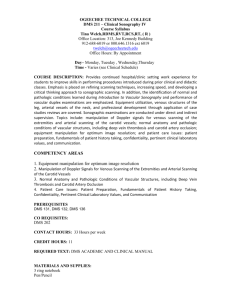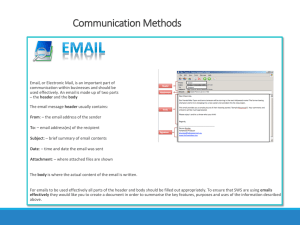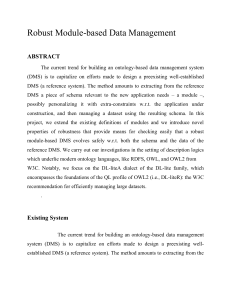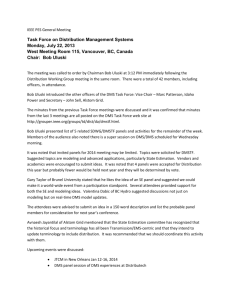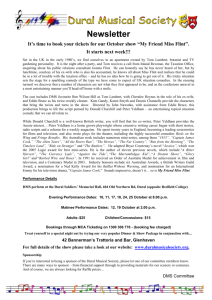Information Domain Modeling for Adaptive Web Systems
advertisement
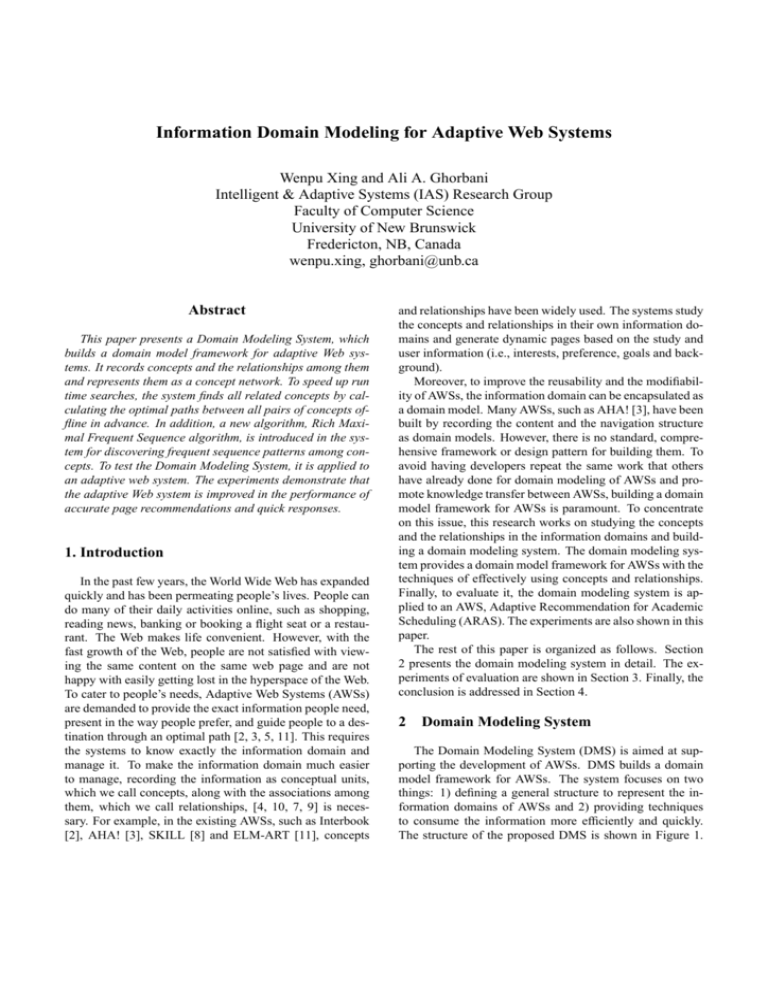
Information Domain Modeling for Adaptive Web Systems
Wenpu Xing and Ali A. Ghorbani
Intelligent & Adaptive Systems (IAS) Research Group
Faculty of Computer Science
University of New Brunswick
Fredericton, NB, Canada
wenpu.xing, ghorbani@unb.ca
Abstract
This paper presents a Domain Modeling System, which
builds a domain model framework for adaptive Web systems. It records concepts and the relationships among them
and represents them as a concept network. To speed up run
time searches, the system finds all related concepts by calculating the optimal paths between all pairs of concepts offline in advance. In addition, a new algorithm, Rich Maximal Frequent Sequence algorithm, is introduced in the system for discovering frequent sequence patterns among concepts. To test the Domain Modeling System, it is applied to
an adaptive web system. The experiments demonstrate that
the adaptive Web system is improved in the performance of
accurate page recommendations and quick responses.
1. Introduction
In the past few years, the World Wide Web has expanded
quickly and has been permeating people’s lives. People can
do many of their daily activities online, such as shopping,
reading news, banking or booking a flight seat or a restaurant. The Web makes life convenient. However, with the
fast growth of the Web, people are not satisfied with viewing the same content on the same web page and are not
happy with easily getting lost in the hyperspace of the Web.
To cater to people’s needs, Adaptive Web Systems (AWSs)
are demanded to provide the exact information people need,
present in the way people prefer, and guide people to a destination through an optimal path [2, 3, 5, 11]. This requires
the systems to know exactly the information domain and
manage it. To make the information domain much easier
to manage, recording the information as conceptual units,
which we call concepts, along with the associations among
them, which we call relationships, [4, 10, 7, 9] is necessary. For example, in the existing AWSs, such as Interbook
[2], AHA! [3], SKILL [8] and ELM-ART [11], concepts
and relationships have been widely used. The systems study
the concepts and relationships in their own information domains and generate dynamic pages based on the study and
user information (i.e., interests, preference, goals and background).
Moreover, to improve the reusability and the modifiability of AWSs, the information domain can be encapsulated as
a domain model. Many AWSs, such as AHA! [3], have been
built by recording the content and the navigation structure
as domain models. However, there is no standard, comprehensive framework or design pattern for building them. To
avoid having developers repeat the same work that others
have already done for domain modeling of AWSs and promote knowledge transfer between AWSs, building a domain
model framework for AWSs is paramount. To concentrate
on this issue, this research works on studying the concepts
and the relationships in the information domains and building a domain modeling system. The domain modeling system provides a domain model framework for AWSs with the
techniques of effectively using concepts and relationships.
Finally, to evaluate it, the domain modeling system is applied to an AWS, Adaptive Recommendation for Academic
Scheduling (ARAS). The experiments are also shown in this
paper.
The rest of this paper is organized as follows. Section
2 presents the domain modeling system in detail. The experiments of evaluation are shown in Section 3. Finally, the
conclusion is addressed in Section 4.
2 Domain Modeling System
The Domain Modeling System (DMS) is aimed at supporting the development of AWSs. DMS builds a domain
model framework for AWSs. The system focuses on two
things: 1) defining a general structure to represent the information domains of AWSs and 2) providing techniques
to consume the information more efficiently and quickly.
The structure of the proposed DMS is shown in Figure 1.
Domain Modeling System
na
Author Tool
sets
Domain Model
used by
Recommendation
Provider
request
Concepts
sets
provides
sets
Pattern Miner
Environment
response
Relationships
uses
concept
remmendation
uses
sets
uses
Graph Generator
usage
data
Figure 1. The Structure of the Domain Modeling System (DMS)
The system consists of a data model, namely domain model,
and four processors, namely author tool, pattern miner,
graph generator and recommendation provider. The domain model encapsulates the information domain and describes how it is represented as concepts and relationships.
The processors provide the functionalities of constructing
and consuming the domain model. First of all, the author
tool provides an interface for authors to input concepts and
relationships to AWSs. Then new relationships are retrieved
from the existing relationships or usage data and recorded in
the domain model by the pattern miner. After that, the graph
generator builds a concept network and finds out the optimal
paths for each pair of the concepts based on the priorities of
the concepts and the relationships stated in the concept network. Finally, the recommendation provider generates concept recommendations to given requests by using the optimal paths and other necessary information in the domain
model.
2.1 Domain model
2.1.1 Concepts
Concepts are the fundamental classifications or units of information within the system. According to the information
included, concepts in DMS are divided into two categories:
atomic concepts and composite concepts (as shown in Figure 2). Atomic concepts are a special kind of composite
concept. They are the smallest items recorded in the domain model and do not need to be further broken down.
For example, an icon, an image, or a fragment of text is
an atomic concept. Composite concepts are those that consist of several other composite concepts, which can be composite concepts or atomic concepts. However, a composite
concept cannot be constituted by its sub concepts.
Composite
Concepts
*
1
Atomic
Concepts
Figure 2. Concept categorization
The domain model represents the information domain as
conceptual units, which are concepts, along with the associations among them, which are relationships. To record
the concepts and the relationships in a common structure
and then to facilitate information exchange between applications within different domains, a general structure, Ontology, is presented. The detailed information is described in
the following subsections.
2.1.2 Relationships
A relationship describes in what way (if any) two concepts
are related and to what degree that relationship exists. In
DMS, two kinds of relationships are considered: predefined
relationships, which are those defined by the author, and
discovered relationships, which are those mined by the system from the usage data.
Predefined Relationships: the relationships that can be observed by studying the information domain. To state the
generalization of these relationships to AWSs, the predefined relationships in DMS are further divided into two
groups based on their life scopes: domain independent,
which are independent from any domain specific concepts,
and domain specific, which are dependent on some domain
specific concepts and will not be listed until an application
domain is specified. The domain independent relationships
considered in DMS are listed as follows:
1. IsA(a,b): Concept a is a concept b iff a is defined as a
sub concept or an instance of b.
2. Prerequisite(a,b): Concept a is a prerequisite of concept b iff accessing b requires knowing a.
3. Co-requisite(a,b): Concept a is a co-requisite of concept b iff they must be processed together.
4. Inhibition(a,b): Concept a is an inhibition of concept
b iff a should not be accessed after accessing b.
5. Similarity(a,b): Concept a is similar to concept b iff
their contents are similar.
6. Containment(a,b)/Member(b,a): Concept a contains
concept b and b is a member of a iff b is held within
container a.
7. Whole(a,b)/Part(b,a): Concept b is a part of concept
a iff an occurrence of a would necessarily involve an
occurrence of b, but not vice versa.
1. Association(a,b): Concept a is an association of concept b iff the presence of a in the sessions implies the
presence of b.
2. MaximalFrequentSequence(a,b,c,d): The sequence (a,
b, c, d) is a maximal frequent sequence iff the following three requirements are met: 1) these concepts are
always presented in order in the sessions; 2) the occurrence of the sequence in the sessions is greater than
the given threshold value; and, 3) the sequence is not
contained in any other longer frequent sequences.
2.1.3 Ontology
Ontology has become a popular word in information- and
knowledge-based systems research, such as the Semantic
Web [6], and has been developed in artificial intelligence to
facilitate knowledge sharing and reuse. Ontologies play a
key role in advanced information exchange as they provide
a common understanding of a domain. In DMS, we present
an ontology to represent the domain model by describing
the vocabulary and structure of the information those domains contain. Figure 3 shows the structure of the ontology. The Ontology contains the concepts and the relationships and provides an interface to query, update, and create
them. Each concept is represented by a set of attributes that
are descriptive properties possessed by each instance of the
concept. Each concept has one or more values for each of
its attributes. Each relationship associates with one source
concept and one target concept.
Ontology
1
8. Sibling(a,b): Concept a is a sibling of concept b iff
they are contained in the same concept. For example, part(a,x) and part(b,x), or member(a,y) and member(b,y) are satisfied.
Concept
9. Equivalent(a,b): Concept a is equivalent to concept b
iff they are essentially equal.
Attribute
10. Complement(a,b): Concept a is a complement of concept b iff they are totally different and the union of
them constitutes the universe.
11. Link(a,b): Concept b is a link of concept a iff a direct
link from a to b exists.
Discovered Relationships: the patterns among concepts
observed from the usage data. They cannot be found by analyzing only the information domain. Because associations
and frequent sequences of concepts are popularly used in
electronic systems (i.e., e-commerce or e-learning) for providing recommendations, DMS defines the following two
discovered relationships:
*
1
1
1
source
*
* Relationship
1
target
*
*
1
*
Value
Figure 3. Ontology structure of DMS
2.2 Processors
In contrast to the domain model, which provides a data
structure for AWSs, the processors of DMS present functionalities of setting data, discovering useful information
from the available data, and generating recommendations.
Detailed information is provided in the following subsections.
2.2.1 Author Tool
The author tool is a component of DMS for authors to interact with the system. By using this tool, authors can send
requests for retrieving, updating, or adding the concepts and
the relationships from or to the domain model. The system
manipulates the concepts or the relationships according to
the given requests. With the tool, authors can set all necessary concepts and the relationships between them to the
domain model. However, with the exponential growth of
Web systems, this task becomes not only time consuming
but also challenging. To reduce the workload of the authors caused by figuring out the relationships that can be
derived from available data, the system provides two relationship finders: sibling finder and similarity finder. The
sibling finder discovers siblings from the relationships of
containment and whole based on the definition of sibling relationship. The similarity finder discovers similar concepts
by analyzing the topics contained in the concepts. Furthermore, to check the consistence and the integrality of the
relationships, a relationship checker is provided based on
the properties of the relationships and the implications between them. For example, sibling(a,b) implies sibling(b,a)
and containment(a,b) implies member(b,a).
2.2.2 Pattern Miner
The pattern miner provides two sub-miners, Association
Miner and Rich Maximal Frequent Sequence Miner, to find
the discovered relationships defined in DMS from usage
data, respectively.
1. Association Miner: is used to discover the association
relationships from the Web access logs. The miner applies the APRIORI algorithm. APRIORI was originally proposed by Agrawal in [1] in 1994 to find frequent itemsets and association rules in a transaction
database. Now, it is the most basic and well-known
algorithm to find frequent itemsets. The algorithm
generates association rules by following the following
process: at first, all frequent itemsets, whose occurrence is greater than a given threshold value of support, are incrementally discovered from the transaction
database (for example, the itemsets with length k are
spread from the itemsets with length k − 1); next, rules
between the frequent itemsets are generated by checking the probability of the transactions containing both
of the itemsets (for example, the association(a,b) holds
iff the probability of the sessions containing both a
and b is greater than the threshold value of confidence).
The algorithm provides an efficient way to generate the
candidate itemsets in a database pass by using only the
itemsets found large in the previous pass. Algorithm 1
shows the algorithm. Detailed information is described
in [1].
Algorithm 1 APRIORI Algorithm [1]
Input:
D: database
Output:
all frequent itemsets.
Method:
1) L1 = {large 1-itemsets};
2) for (k = 2; Lk−1 6= ∅; k + +) do begin
3)
Ck = apriori-gen(Lk−1 );//New candidates
4)
forall transactions t ∈ D do begin
5)
Ct = subset(Ck , t);//Candidates contained in t
6)
forall candidates c ∈ Ct do
7)
c.count++;
8)
end
9)
Lk = {c ∈ Ck | c.count ≥ minsup}
10) end S
11) return k Lk ;
2. Rich Maximal Frequent Sequence Miner: is used to
discover the traversal patterns, maximal frequent sequences, from Web access logs. A Frequent Sequence
Tree (FSTree), a tree-like data structure, is introduced
to record the frequent items and the maximal frequent
sequences. The tree is constructed by following these
steps. Firstly, an empty tree is defined with a root
node only. Secondly, the frequent 1-item sequences
are found by counting their occurrences in the sessions
and added to the tree as child nodes of the root. Within
each node, the occurrence of the included item and the
path from the root to the current node are recorded
to speed up later searches. Thirdly, for each node,
M SN ode, in the newly updated level of the tree, every
frequent 1-item C is considered as a potential child and
a corresponding candidate frequent sequence is generated by appending C to the current path recorded in
the node. Then, the candidate’s occurrence is counted
by observing the sessions. If the candidate is frequent, C will be added to the tree as a child node of
MSNode with the candidate sequence and its occurrence. Fourthly, step three will be continued until the
construction of the tree is well done. In the finished
FSTree, all maximal frequent sequences are recorded
in the leaf nodes as their current path.
Moreover, to speed up decision making at the cross
points of similar sequences (i.e., (a, b, c, d) and
(a, b, c, e)), weights are added to the sequences to identify the priority of step choices. For example, the sequence (c1 , c2 , c3 ) becomes ( c1 , wc1 c2 , c2 , wc2 c3 , c3 ),
where wci ci+1 denotes the priority of the choice from
ci to ci+1 . Sequences with weights are called rich
frequent sequences while the algorithm that generates
them is call Rich Maximal Frequent Sequence algorithm (RMFS). The pseudocode of RMFS is shown as
Algorithm 2.
Algorithm 2 RMFS Algorithm
Input:
S1 , S2 ,...,Sn :sessions.
smin :minimum support threshold.
Output:
all rich maximal frequent sequences (RMFSs)
Method:
1)
F ST ree = an empty sequence tree;
2)
F S1 = {frequent 1-item sequences};
3)
update(F ST ree, F S1 );
4)
for( k = 2; F Sk−1 6= ∅; k + +) do
5)
F Sk−1 = {sequences with length k − 1 in ST };
6)
Ck = genPathCandidate(F Sk−1 );
7)
for i from 1 to n do
8)
count(Ck , Si );
9)
F Sk = {p ∈ Ck |p.count ≥ smin }
10)
update(F ST ree, F Sk );
11)
RMFSs = richPathsGen(F ST ree);
12)
return RMFSs;
their priorities. The weight of a concept a is propagated from its referrer concepts that are concepts
linked to it. A concept gets one value proportional to
its popularity (numbers of inlinks and outlinks) from
each referrer concept. The popularity from the number
in
out
of inlinks and outlinks is recorded as P(v,u)
and P(v,u)
,
in
respectively. P(v,u) is the popularity of link(v, u) calculated based on the number of inlinks from concept
v to concept u and the number of inlinks of all referout
ence concepts of concept v. P(v,u)
is the popularity of
link(v, u) calculated based on the number of outlinks
of concept u and the number of outlinks of all reference concepts of concept v.
in
P(v,u)
=P
Iv,u
c∈R(v) Ic
out
P(v,u)
=P
Ou
c∈R(v)
Oc
(1)
(2)
where Iv,u represents the number of inlinks from concept v to concept u. I(c) represents the number of
inlinks of concept c. Ou and Oc represent the number
of outlinks of concept u and concept c, respectively.
R(v) denotes the reference concept list of concept v.
The weight of a concept is calculated by summing up
the products of each referrer concept’s weight and corresponding popularity.
W (u) =
X
in
out
W (v)P(v,u)
P(v,u)
(3)
v∈B(u)
2.2.3 Graph Generator
Because AWSs generate dynamic pages to the given requests on the fly, response time is a main concern. Therefore, processing as much information as possible in advance
is necessary. The graph generator provides such a technique
to accelerate the information query for providing recommendations by building a concept network and finding all
optimal paths between each pair of concepts. The process
is described as follows:
• Building a concept network: Firstly, DMS builds
a concept network by representing the concepts as
nodes, and the relationships as links. At this step, multiple links are allowed between nodes because multiple
relationships might exist between concepts.
• Setting weights to the concepts and the relationships: Secondly, to emphasize the importance of the
concepts and the relationships to the system, weights
are set. The more important they are, the larger
weights they will have. The weights of the relationships can be set arbitrarily by the author according to
where B(u) is the set of concepts that link to concept
u. W (u) and W (v) represent the weights of concepts
u and v, respectively. The weights of the concepts and
the relationships are set to the corresponding nodes and
links in the concept network.
• Combining the multiple links between nodes: To
reduce the search time through the concept network,
multiple links between nodes are combined. The multiple links are combined to a single link, and the maximal weight of the links is set to the combined link.
• Finding related concepts: Finding related concepts
for each concept off-line in advance is another efficient
method to reduce the response time of AWSs. The related concepts are discovered by calculating optimal
paths between each pair of concepts according to the
importance of concepts and relationships. Equation 4
is defined to calculate the paths’ weights. The path
with the largest weight is defined as the optimal path
and saved into the domain model.
P
W (Ci ) × W (Ci−1 Ci )
n−1
(4)
where PCs Ct is any path from the source concept Cs
to the target concept Ct . W (PCs Ct ) represents the
weight of the path PCs Ct . n is the number of concepts on the path. Ci denotes the ith concept on the
path. W (Ci ) and W (Ci−1 Ci ) represent the weights
of concept Ci and link Ci−1 Ci , respectively.
W (PCs Ct ) =
i = 2 to n
2.2.4 The Recommendation Provider
Finally, a built-in recommendation provider is introduced
into DMS to recommend related concepts to the given requests. Once DMS receives a request about a specific concept, the system checks the information contained in the
request. If there is any user’s information (i.e., interests,
browsed history in the current session), the information is
passed to the recommendation provider with the requested
concept. Otherwise, only the requested concept is passed.
The recommendation provider finds a list of closely related
concepts to the requested concept and/or the user information according to the optimal paths and the discovered patterns of association and maximal frequent sequences stated
in the domain model. The name and/or URLs of the related
concepts are passed to DMS. At the end, DMS provides the
requested concept with these recommended concepts to the
given request as a response.
3 Evaluation
For the purpose of evaluating our work, DMS is applied to an AWS, Adaptive Recommendation for Academic
Scheduling (ARAS). ARAS is an online system that aims
to provide adaptive support to the course selection process
for students without the assistance of advisors. The system
generates recommendations to students based on course information, and users’ interests and course-taken history.
To demonstrate the helpfulness of DMS to ARAS, three
sample systems are developed and compared based on their
performance:
• System A: in which only relationships prerequisite and
containment are considered. Once the system receives
a concept request, it searches through the relationships
and concepts and finds related concepts online for the
given request based on the user’s interests.
• System B: in which all predefined relationships defined in DMS are considered. The system finds all related concepts for each concept in the domain model
in advance off-line by following the process described
in section 2.2.3. Once the system receives a concept
request, it provides the related concepts of the given
request from its recorded related concept list immediately.
• System C: in which all predefined relationships defined in DMS are considered. Similar to system B,
the related concepts of each concept are found offline in advance based on these relationships and concept information. In addition, the discovered relationships, which are associations and maximal frequent
sequences, are discovered in advance in this system.
Once the system receives a concept request, the system not only finds the related concepts of the given
request from its recorded related concept list, but also
generates recommendations based on the associations
and the maximal frequent sequences.
The performance of these systems is measured in two
ways: accuracy of recommendations, and response time of
requests. The accuracy of recommendations measures how
close the recommendations are to what users want. The response time measures how fast the system can provide the
requested concept to users. In this research, the accuracy
of recommendations is calculated based on two parameters:
recall and precision. Recall is the portion of the number of
concepts recommended correctly by the system to the number of concepts the users really want. Precision is the portion of the number of concepts recommended correctly by
the system to the total number of recommended concepts.
Since ARAS takes the University of New Brunswick,
Fredericton, Canada, as the sample application domain, the
real data of the students at the university is used as sample
data for DMS. The sample data is preprocessed in two steps:
firstly, a set of data is separated from the sample data set for
mining the discovered relationships; then, the rest of the
data is divided into training data sets and test data sets: the
courses taken in each student’s last term are considered as
a test set, which represents what the student wants, and the
courses taken in previous terms are considered as a corresponding training set, which represents the student’s course
taken history. The system generates recommendations for
each student based on course information, curriculum information, and students’ interests, which are discovered from
the student’s course taken history. The recommendations
are measured against the corresponding test data set.
Figure 4 presents the accuracy of the recommendations
provided by the three sample systems. In the graph, the
number of relationship types considered in the system is
shown as the x-axis while accuracy is taken as the y-axis.
The graph shows that the more relationships are considered
in the system, the bigger recalls but smaller precisions the
recommendations have because the more recommendations
are provided. However, since the decrement ratio of the
precisions is less than the increment ratio of the recalls, Sys-
tems B and C provide better recommendations. Therefore,
DMS represented by System C improves the performance
of ARAS in accuracy of recommendations.
60
Recall
Precision
50
References
Accuracy (%)
40
30
20
10
0
3
4
5
6
7
8
9
Number of Relationship Types
10
11
12
13
Figure 4. Accuracy of the Sample Systems
To measure the response time, the average response time
of requests is calculated in the sample systems. The results
are shown in Table 1. The key point of the results is that
even though many more relationships are considered in Systems B and C, their response times are still less than that of
System A. This result shows that DMS accelerates ARAS’
responses.
System A
System B
System C
tems. In the future, discovering techniques for generating
relationship weights automatically based on concept information is planed. In addition, the system is planned to be
extended with an ontology proxy for exchanging information between different domains.
Average Response Time(millSec)
2740200
2020
2555
Table 1. Average response time of the sample
systems
In general, improvements of DMS to ARAS in accuracy of recommendations and response time demonstrate
that DMS improves the performance of ARAS.
4 Conclusion
In this paper, a domain modeling system is presented.
The system not only provides a list of general concept relationships in AWSs, but also introduces a general structure
for recording domain information for AWSs. Moreover, in
order to improve the performance of AWSs, techniques of
effectively using the domain information are addressed. Finally, the feasibility of the domain modeling system is presented by the experiment comparisons of three sample sys-
[1] R. Agrawal and R. Srikant. Fast algorithms for mining association rules. In J. B. Bocca, M. Jarke, and C. Zaniolo,
editors, Proc. 20th Int. Conf. Very Large Data Bases, VLDB,
pages 487–499. Morgan Kaufmann, 12–15 1994.
[2] P. Brusilovsky, J. Eklund, and E. Schwarz. Web-based education for all: A tool for developing adaptive courseware.
In Computer Networks and ISDN Systems (Proceedings of
Seventh International World Wide Web Conference), pages
291–300, April 1998.
[3] P. De Bra and L. Calvi. AHA: a generic adaptive hypermedia system. In Proceedings of the 2nd Workshop on Adaptive
Hypertext and Hypermedia, HYPERTEXT‘98, Pittsburgh,
USA, June 20–24 1998.
[4] C. Eliot, D. Neiman, and M. Lamar. Medtec: A web-based
intelligent tutor for basic anatomy. In World Conference of
the WWW, Internet, and Intranet (Web-Net’97), pages 161–
165, Toronto, Canada, October 1997.
[5] M. Kilfoil, A. Ghorbani, W. Xing, Z. Lei, J. Lu, J. Zhang,
and X. Xu. Toward an adaptive web: The state of the art
and science. In Proceedings of Communication Network and
Services Research (CNSR) 2003 Conference, pages 108–
119, Moncton, NB, Canada, May 15–16 2003.
[6] M. Klein, J. Broekstra, D. Fensel, F. van Harmelen, and
I. Horrocks. Spinning the Semantic Web, chapter 4, pages
95–141. The MIT Press, 2003.
[7] W. Nejdl and M. Wolpers. Kbs hyperbook – a data-driven
information system on the web. In WWW8 Conference,
Toronto, May 1999.
[8] G. Neumann and J. Zirvas. Skill - a scalable internet-based
teaching and learning system. In Proceedings of WebNet 98,
World Conference on WWW, Internet and Intranet AACE,
pages 7–12, Orlando, Fl, November 1998.
[9] M. Specht and R. Opermann. Ace - adaptive courseware
environment. The New Review of Hypermedia and Multimedia, 4:141–161, 1998.
[10] M. Specht, G. Weber, S. Heitmeyer, and V. Schoch. Ast:
Adaptive www-courseware for statistics. In Workshop on
Adptive Systems and User Modeling on the World Wide Web
at UM’97 Conference, pages 91–95, Chia Laguna, Sardinia,
Italy, June 1997.
[11] G. Weber and M. Specht. User modeling and adaptive navigation support in www-based tutoring systems. In Proceedings of User Modeling’97, pages 289–300, 1997.
